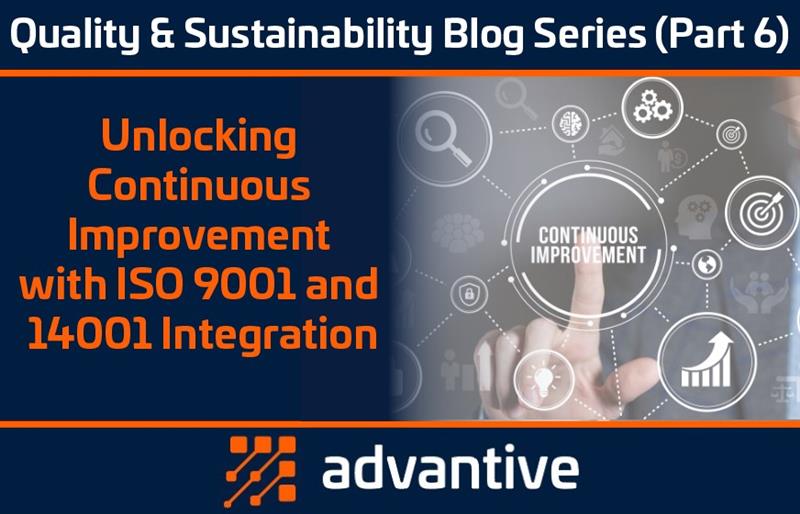
We’re back with the final installment of our Quality & Sustainability blog series! In our previous post, we explored how real-time data monitoring helps manufacturers optimize process inputs and leverage automation for impactful results.
This week, we’re wrapping up with ISO 9001 & 14001 integration – which provide a robust framework for continuous improvement. Let’s explore how this can help manufacturers achieve regulatory compliance, enhance operational efficiency, and maintain critical certifications with ease.
ISO 9001 & ISO 14001 Integration
The integration of ISO 9001 & ISO 14001 creates a comprehensive approach to continuous improvement. This alignment empowers manufacturers to enhance product quality while meeting environmental goals.
Compliance is Foundational for Success
Achieving compliance in three key areas ensures your operations meet the stringent industry requirements while building the foundation to continuously improve your processes.
Collection Compliance
You need to ensure that you’re collecting the necessary data. In an earlier blog, we discussed how timed data collection ensures that you can maintain a record of your operations.
Let’s say you’re looking at the data for the month of January. You want to know how effectively you measure everything necessary for one machine, how effectively you measure for all the machines in the facility, and how effectively you maintain compliance.
A review of the data might reveal a 95% compliance rate with the data collection. What about the remaining 5%? It’s an opportunity for you to identify and resolve issues.
When collection compliance comes up in an audit, you have the information necessary to explain why something happened and when.
Quality Compliance
Quality compliance is similar to collection compliance You’re measuring the product to identify whether it’s good or bad. By proactively monitoring your data, you can help maintain a stable production process while preventing defects before they occur. You can shift responsibility upstream to catch and resolve potential issues early, ensuring the quality of the final product.
When auditors ask about quality challenges, you can confidently present a record showing proactive quality management and evidence of minimal quality issues.
Compliance to Procedure
The last type of compliance is your procedure. ISO standard emphasize say what you do and doing what you say. This includes assignable cause codes and corrective action codes to explain issues, document responses, and evaluate outcomes. Comprehensive records demonstrate adherence to procedures and regulatory compliance during audits.
Verification Ensures Safety & Consistency
Verification processes ensure your products and equipment meet critical safety and quality standards.
CCP & HACCP Checks and Metal Detection
Critical Control Points (CCP) and Hazard Analysis Critical Control Points (HACCP) can help you identify and monitor critical areas to avoid issues.
For example, a food company needs to ensure that there’s no metal contaminants in food products. You need to have proof that you completed this check and that there was no metal in the product. This should be easily disproven since you have verification and records of your processes.
Machine Cleanliness
Machine cleanliness is extremely important, especially if you have products that could be cross-contaminated such as allergen-sensitive products.
Let’s say you produce nuts and non-nuts on the same machine. You must go through a rigorous cleaning between the two products because of allergies. When you run the machine through the inspection and testing, the results say there are not enough particles to create allergy problems. Now, you have a record that these tests occurred and were verified.
An automated quality software can provide a reliable, traceable record of cleaning and testing. You can also record the information on paper, but it is more credible going through quality software since it occurs automatically, and nobody can skip it.
With these systems in place, manufacturers can easily verify compliance and produce receipts for both internal reviews and external audits.
Maintaining Certification for Ongoing Compliance
Once you achieve certification, ongoing audits ensure that you continue to meet compliance requirements. Robust record keeping can ensure you simplify this process.
Expedited Audits
Organizing your data can ensure recertification audits can be completed in a timely manner. It may be possible to shrink these audits from days to mere hours.
Historical Proof of Compliance
The historical proof of compliance makes audits much easier, where you have the evidence to back yourself up whenever the auditors have a question.
Let’s say the auditors ask to show what happened over the past six months. You had three problems, but because you kept the historical proof of compliance, you can explain what happened and why.
By leveraging the data from your quality system, you can simplify the process of obtaining and maintaining certifications with minimal disruption and maximum confidence.
Thank You for Reading Our Quality & Sustainability Blog Series
Thank you for joining us on this journey to connect quality management with sustainability for real-world results. Over the course of this series, we’ve explored practical strategies to:
- Implement sustainable practices that optimize operations and reduce waste
- Enhance product quality and operational efficiency using existing standards and processes
If you missed our previous blogs, be sure to check them out:
Ready to Elevate Your Quality Standards?
Discover how our quality solutions – InfinityQS, WinSPC, and PQ Systems – can support your business in achieving higher quality standards and operational efficiency. Take your manufacturing excellence and quality to the next level.
Schedule a demo with our team to discuss your needs and experience our solutions in action.